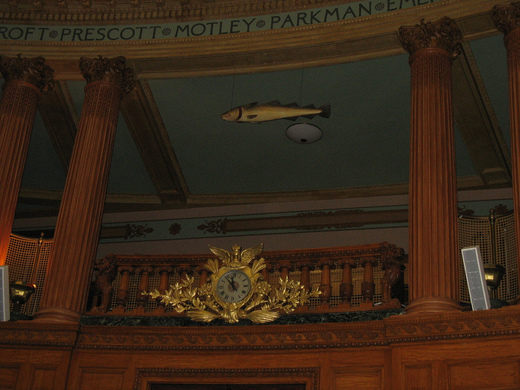Tagged: Atlantic Standard Time
Stop the Clock: Implications of Switching Time Zones
The holiday season is joyous for many reasons; from family, friends, and food, there is ample joy and merriment to go around. There is one aspect of the season that doesn’t match these factors; especially in New England – darkness. At the outset of winter, on December 21st each year, the sun sets in Boston at 4:11pm. There are many negative effects of darkness setting in before the end of the workday – with increased crime, traffic accidents, and seasonal depression being one of the most paramount. Boston’s sunset is not the earliest in the area, with municipalities in Maine experiencing sunsets earlier than 4pm; but it is the earliest of the major cities, beating out Buffalo, NY despite being further south.
Early sunsets do not become apparent in New England until clocks fall back in line with the change from Daylight Savings Time. Daylight Savings is a federal program instituted during World War II that the country has become accustomed to; the federal legislation only permits states to opt out of the program, but it does not allow states to make the program permanent, which would keep the clocks from falling back an hour. Hawaii and Arizona have opted out of the program – made available through the US Energy Policy Act of 2005, allowing any state that lies entirely within one time zone to opt out.
New England states, primarily Massachusetts and Maine at this point, have been considering a change to the Atlantic Time Zone
in order to increase the number of waking hours with sunlight. With a change to Atlantic Time, and subsequent opting out daylight savings, New England would be out of sync with the rest of the Eastern Time Zone from November to March, or the period in which clocks “fall back” in line with daylight savings in the Eastern Time Zone. A transfer to Atlantic Standard Time – which includes Puerto Rico, the Virgin Islands and eastern Canada – would mean jumping an hour ahead of the Eastern time zone from November to February. The time zones would align from March to October.
While the benefits of having an extended amount of light in the evening hours are readily apparent, there are several drawbacks that accompany a change. Early risers in particular, who are likely accustomed to the sun being out while they start their days have reason to complain. School aged children may be leaving to their schools in darkness in the morning, and businesses that transact on financial markets may be put out of sync with the markets they depend on.
If New England were to change to Atlantic time, there would be a two-step process. First, the interested states would have to decide to leave. Second, the states would have to consult the US Department of Transportation, the cabinet agency that regulates time zones. States, municipalities, business interests, and others would have the opportunity to weigh in during both steps.
 There could be major issues with “commerce, trade, interstate transportation and broadcasting” if one state moves ahead one hour while its neighboring states remain in the Eastern Time Zone. It seems to be a requirement of widespread support and agreement for any change in this area to take effect. Lawmakers in Maine might support the change – in May 2017, Maine’s Senate passed a bill that would move the state to the Atlantic Time Zone — if approved by residents in a state-wide referendum. Maine conditioned the change, subject to their approval, on Massachusetts and New Hampshire.
There could be major issues with “commerce, trade, interstate transportation and broadcasting” if one state moves ahead one hour while its neighboring states remain in the Eastern Time Zone. It seems to be a requirement of widespread support and agreement for any change in this area to take effect. Lawmakers in Maine might support the change – in May 2017, Maine’s Senate passed a bill that would move the state to the Atlantic Time Zone — if approved by residents in a state-wide referendum. Maine conditioned the change, subject to their approval, on Massachusetts and New Hampshire.
Some states seem to have considered the idea and decided against it, with the New Hampshire Senate voting against a bill that would move the state to the Atlantic Time Zone by a 16 to 7 vote; at the same time, the bill passed the house with a voice vote. While there has yet to be an affirmative move, the proponents of the change are enlivened by the action around the issue and are hopeful for the future.
Massachusetts established a commission to study the issue. In a neutral report neither supporting or disavowing the change, the commission stated its findings that “People tend to shop, dine out, and engage in other commercial activities more in after-work daylight,”. . . “Year-round DST could also increase the state’s (competitiveness) in attracting and retaining a talented workforce by mitigating the negative effects of Massachusetts’ dark winters and improving quality-of-life.” More daylight could also reduce street crime, on-the-job injuries and traffic fatalities, and boost overall public health, the commission found.
States in the Northeast seem intrigued by the change, but alterations of the particulars of their citizen’s days are deeply personal to their citizens may be a drastic change to take without widespread public support. In Arizona, the effects of their non-adherence to daylights savings time are apparent when the state is out of sync with the rest of the surrounding states – constant clarification of what time is in effect, setting different meeting times, etc. Results on an individual basis are a mixed bag, with businesses that are purely local and that thrive in the daylight being supporters of the longer day due to increased business, and those who constantly run up against timing differences by virtue of dealing with other regions.
It will be interesting to observe if public support for a time zone change increases as people in New England become aware that doing so is a possibility to increase their daylight hours in the depths of winter. In any case, it is clear that the states’ legislatures have identified it as a possible issue.
 Drew Kohlmeier is a student in the Boston University School of Law Class of 2020 and is a native of Manhattan, KS, graduating with a degree in Biology from Kansas State University in 2016. Drew decided on Boston for law school due to his interest in health care and life sciences, and will be practicing in the emerging companies space focused on the life sciences industry following his graduation from BU.
Drew Kohlmeier is a student in the Boston University School of Law Class of 2020 and is a native of Manhattan, KS, graduating with a degree in Biology from Kansas State University in 2016. Drew decided on Boston for law school due to his interest in health care and life sciences, and will be practicing in the emerging companies space focused on the life sciences industry following his graduation from BU.


